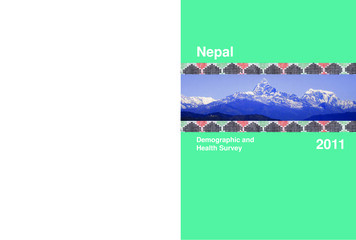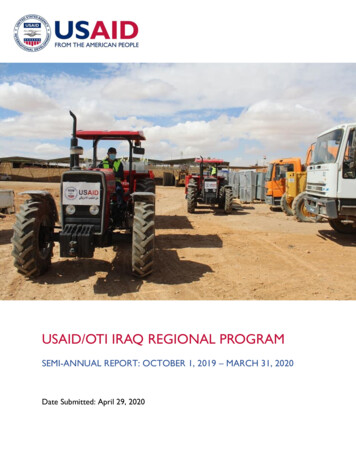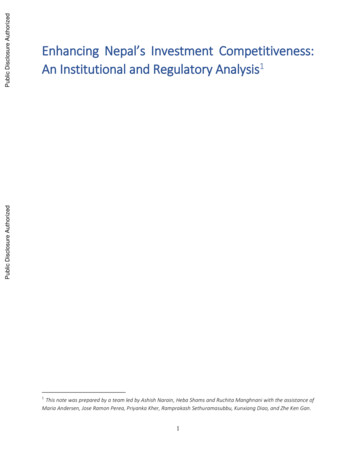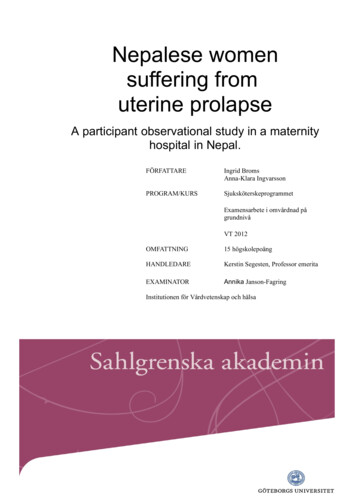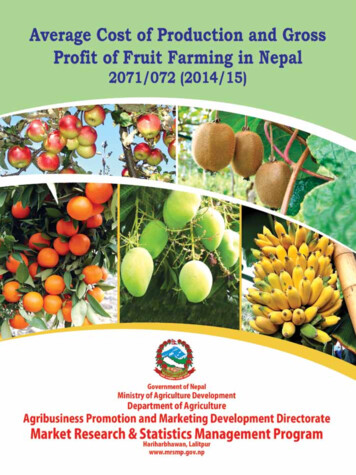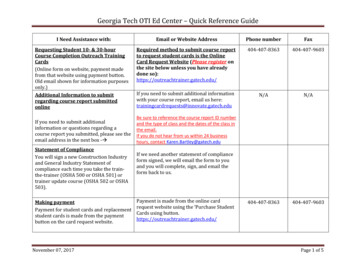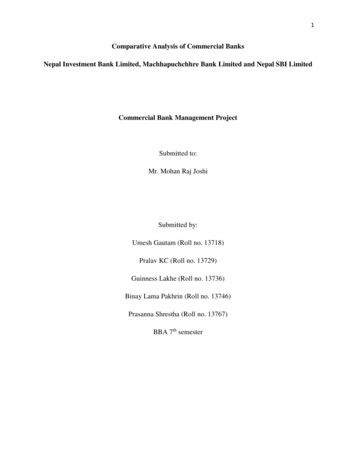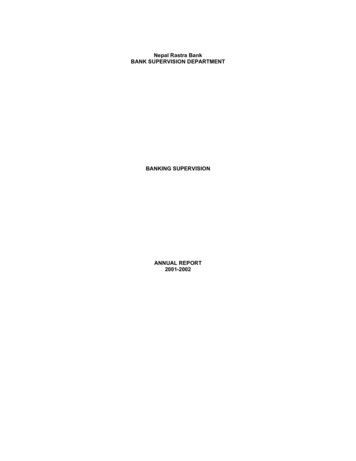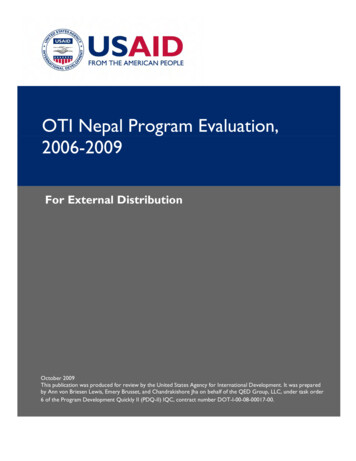
Transcription
OTI Nepal Program Evaluation,2006-2009For External DistributionOctober 2009This publication was produced for review by the United States Agency for International Development. It was preparedby Ann von Briesen Lewis, Emery Brusset, and Chandrakishore Jha on behalf of the QED Group, LLC, under task order6 of the Program Development Quickly II (PDQ-II) IQC, contract number DOT-I-00-08-00017-00.
Nepal Program Evaluation, 2006-2009Prepared for the Office of Transition InitiativesBureau for Democracy, Conflict, and Humanitarian AssistanceUnited States Agency for International DevelopmentFinal ReportOn behalf of the QED Group, LLCAnn von Briesen Lewis (Team Leader)Emery BrussetChandrakishore Jha
This document has been prepared on behalf of the QED Group, LLC, and is commissioned by USAID/OTI.The material contained here is confidential and can be disseminated only on the condition of informing the evaluation team leader or QED.Please address all communications concerning the document to:Mrs Ann von Briesen Lewisavblewis@comcast.net2006-2009 Office of Transition Initiatives Nepal Program Evaluationii
Table of ContentsAbbreviations and AcronymsivExecutive Summary11 BACKGROUND1.1 OTI Mission and Approach71.2 The Transition in Nepal1.3 OTI Nepal’s Funding and Program Focus Timeline1.4 Evaluation Approach and Methodology2 MANAGEMENT2.1 Appropriateness of OTI Focus and Structure2.2 Media2.3 Flexibility and Responsiveness82.4 Some OTI Approach Limitations3 PROGRAM IMPACT3.1 Relevance of the Impact3.2 Extent of the Impact3.3 Duration/Timeliness of Impact3.4 Conclusions on Impact2013161818232425264 CONCLUSIONS4.1 Lessons to be Learned4.2 RecommendationsAnnex A: List of Persons MetAnnex B: The Conflict Mapping Workshop MethodAnnex C: OTI Mission Statement2728313538Annex D: Scope of WorkAnnex E: Conflict Mapping Workshop ResultsAnnex F: Concepts Behind Program MethodologyAnnex G: Program TimelineAnnex H: Commonly Used Nepalese WordsAnnex I: Sample Grants: Case Studies394344454849Annex J: OTI/Nepal Final Evaluation Team ScheduleAnnex K: Key Documents, Partial Bibliography542006-2009 Office of Transition Initiatives Nepal Program Evaluation58iii
Abbreviations and IUNUSAIDVDCYCLYMCConstituent AssemblyCenter for Constitutional DevelopmentCommunity Development FundCommunity MobilizersChief of PartyComprehensive Peace AgreementUnited Marxist-Leninist partyCountry RepresentativeDeputy Chief of PartyDistrict Development CenterDemobilization, disarmament, reintegrationElectoral CommissionEconomic Support FundFréquence Modulée (quality frequency radio)Grants Operations and Compliance SpecialistGovernment of NepalInternational NGONepali ArmyNepali Congress PartyNongovernmental OrganizationNational Monitoring Committee on Code of ConductU.S. Department of the Treasury, Office of Foreign Assets Control, overseesadherence to restrictions on commerce with Terrorist Groups (including Nepal ese Maoists)Office of Transition InitiativesOTI Program AssistantProgram Development OfficerPeople’s Liberation Army, Maoist forcesProgram Performance ReviewProcurement SpecialistPublic Service AnnouncementsSenior Management TeamTransitional Initiative fundingUnited NationsUnited States Agency for International DevelopmentVillage Development CenterYoung Communist LeagueYouth Management Committees2006-2009 Office of Transition Initiatives Nepal Program Evaluationiv
EXECUTIVE SUMMARYBackgroundFollowing an 11-year armed insurgency, Nepal has achieved a transition from a monarchy to afederal democratic republic. Despite a well-observed ceasefire, public security and rule of law aretenuous. New conflict has risen, driven by unresolved social exclusion, marginalization of ethnicgroups, economic disparities, political fractionalization and lack of state services.The signing of the Comprehensive Peace Agreement (CPA) between the Government of Nepaland the Maoists in 2006 created an opportunity for peace and reconciliation. An interim Constitutionwas promulgated and an interim parliament was elected. In the election, the Maoists won more seatsthan any other party, historically dominant parties suffered unexpected defeats, and new Madeshiparties (from the volatile southern region of Nepal) won significant representation. Nepal was de clared a republic. The Constituent Assembly (CA) was tasked with drafting Nepal’s new constitutionwhile addressing significant social, economic, and political issues.However, constitution drafting, re-establishment of the rule of law, and the addressing of histori cal grievances have seriously lagged; very few elements of the CPA have been resolved, most urgentbeing the integration of the military under civilian control. The long-standing inequalities that fed theoriginal Maoist insurgency have come to a head in central and eastern Terai districts, where Nepal’slandless poor and marginalized groups have long been denied equal access to social, economic, andpolitical resources. Former cadres, new splintered political parties, and criminal gangs joined forceswith disillusioned youth, inflaming historical grievances among frustrated groups in the Terai, andgiving rise to a new wave of conflict in Nepal.OTI InterventionUSAID Office of Transition Initiatives and its implementing partner, Chemonics International,commenced its three-year Nepal program in mid 2006, with the goal “to positively affect the currentpolitical transition in Nepal and help advance Nepal’s transition to peace and democracy.” The initialobjectives were: To increase information access and diversify public debate on issues critical to the political transition.To increase effectiveness of key political transition institutions.At first, OTI focused on national-level support to the peace process, including support to theNational Monitoring Commission for the Ceasefire Code of Conduct, the Electoral Commission, andthe Ministry of Peace. In 2007, OTI opened a field office in Sunsari District to better understandlocal conflict dynamics, identify local organizations, and monitor activities. Following the 2008 CAelections, ethnic violence increased in the Terai, and the OTI program shifted focus to communitylevel peace building and conflict mitigation. The second objective was replaced with a new objectivethat reflected this change in emphasis: To increase local level engagement and participation in the peace process.Over the three-year program period, 20 million has been programmed in over 300 grants madein strategically identified sectors: community stabilization, media strengthening, key political institu tions strengthening, elections, and social inclusion, as a cross-cutting sector. To increase awarenessof the peace process and constitutional issues, OTI supported a wide range of local-level initiatives2006-2009 Office of Transition Initiatives Nepal Program Evaluation1
and media activities. Equipment and training for local radio networks supported vernacular languagebroadcasts on the political transition. Toll-free call-in talk shows with local officials were initiated,and CA members and their constituents took advantage of new opportunities to air grievances anddiscuss local issues. Responding to the changing political situation, OTI worked to cultivate positiveproductive roles and resources for youth leaders in small-scale community development activities(Community Development Fund) through grants to partner Nepalese NGOs. Youth-managed, smallscale projects (school and clinic rehabilitation, road repairs, latrine construction) have reached over400 Village Development Committees in the Eastern and Central Terai. The OTI Program will con tinue at a reduced funding level, subsumedwithin USAID Nepal for an additional twoyears through 09/2011.Excellent documentation of the OTIprocess and the Nepal program (maintainedin the OTI Database) provides extensivereporting of the conduct of the program,adjustments made, and success stories.Internal reporting and documentation ofprogram activities and outputs is thorough,extensive and timely. Reports of nineQuarterly Strategy Review Sessions and twoProgram Performance Reviews chroniclerolling assessments, critical events and ac tion items which tell the story of the flexible, dynamic, and responsive program which exemplifiedOTI Operating Principles and conducted an efficient, well-managed and creative program in Nepal.Background to the EvaluationThis final evaluation was carried out in July 2009 by three independent consultants1 to addressOTI Nepal’s effectiveness in adherence to OTI operating principles and review the outcomes andimpact of the program in Nepal. The evaluation focused on broader, “so what?” questions of howthe program impacts prospects for peaceful transition in Nepal. It also tested and applied evaluationmethodologies that might strengthen OTI’s own internal monitoring capacities. Using Significanceof Impact and other evaluation methodologies, the evaluation team analyzed the impact of the OTIprogram on key conflict drivers, to evaluate the alignment of the program with the reality of the tran sition. The report aims to guide other current OTI programs, serve as a planning tool and to informthe public on OTI’s work in Nepal.Assessment of OTI ManagementThe OTI Nepal Program adhered closely to established OTI programming principles, as exempli fied by its principles of operation.21. Critical issues: The program identified issues critical to the direction and durability of thetransition. For example, the credibility of the CPA and CA process rested in public aware ness and participation, so OTI empowered media to expand access to information and inputin the peace processes.12Ann Lewis, Emery Brusset, Chandrakishore Jha.As presented in the OTI Evaluation Powerpoint, June 10 2009, Washington DC.2006-2009 Office of Transition Initiatives Nepal Program Evaluation2
2. Transition, not development: While short-term, fast, and flexible, the program dovetailedwith and piloted USAID Democracy and Governance development assistance to contributeto longer-term sustainable development. Following the OTI lead, the USAID Nepal Gov ernment Citizen Partnership Project (NGCPP) helps the Government of Nepal (GON) re establish legitimate and effective security and governance. The core objectives are to: (1)support strengthened governance to restore citizen confidence in public institutions; (2) im plement quick-impact activities that ensure the public reaps the peace dividend, encourage jobcreation, and assist with reintegration; and (3) ensure marginalized populations feel connectedto the national-level peace process.3. Support local capacities: The program supported existing capacities, making grants to 175local Nepalese NGOs, many of them never funded before. Basing a field office in the Teraiallowed the program to focus on local processes better than most other donors. The evidenceof strengthening of partner capacity was clear and constitutes an asset that can be handedover to USAID programming. Yet because of reliance on a large number of partners requir ing management time, the program was less effective at cultivating community ownership, orreaching beyond the web of grantee NGOs to other parts of the polity: political parties, reli gious organizations and communities. Grantee NGOs tended to use tried and tested pro gram concepts which they rapidly adapted to the OTI approach, while communities were giv en limited options for action. As a consequence the OTI program struggled to become outward-looking, tending instead to focus on output delivery, rather than on the critical relation ship between partners and population.4. Process-driven, not sector-driven; impact defined in terms of attitudes, behaviors andperceptions.3 Committed to effects and outcomes as well as outputs. Though commit ted to data gathering, monitoring, effects and outputs, the program was not fully able to ar ticulate outcomes and impact or adjust those in innovative ways in relation to the changesnoted in the rolling assessments. The Media Impact assessment documented positivechanges in attitudes and behaviors; the importance of contributions in other sectors is lessclear. This is because between the outputs and the broad changes monitored by OTI, a mid dle level of outcomes and critical conflict issues is missing.5. Get outside the capital, target local actors, move beyond ‘usual suspects,’ activate existing capacities: The program was uniquely and effectively able to get outside the capitaland target local actors, and was frequently able to move beyond “usual suspects”. The abilityto engage in local procurement filled critical gaps in a unique way amongst USAID and donorinstruments. There was a tradeoff between extent of interface and expediency, the emphasison the latter reducing activation of endogenous energies.Impact AssessmentThe evaluation team conducted five conflict mapping workshops in Kathmandu and the Teraiwith diverse language, ethnic, and socio-economic groups to identify events and trends which in creased the likelihood of, or negatively impacted, progress toward peace. The following key drivers(or critical issues) were elicited: The signing and partial implementation of the Comprehensive Peace Agreement A widening disconnect between State and population Increasing numbers of youth joining armed groups Impunity, looting, kidnapping, and high-level complicity Increasing use of violence for political or identity group purposes Identity politics and sub-identity group tensions Bandhs, closures, strikes, and disruption of normal life3OTI Operating Principles, OTI Evaluation Powerpoint, June 10 2009, Washington DC.2006-2009 Office of Transition Initiatives Nepal Program Evaluation3
All these issues have been presented in varying degrees in the OTI assessments and in other con flict analyses. The mapping, however, provided an independent validation, as well as a rudimentarychronology allowing older “drivers” to be taken into account at the time of the intervention.The evaluation team analyzed the alignment of OTI program outputs with these key drivers, as sessing their relevance, extent/quality and timeliness/duration to determine program impact. Thisanalysis showed that the program’s outputs are clearly aligned to the key conflict drivers: More effective institutions (the CA, EC)More diffuse media, with better quality information (through radio, drama, TV)Improved government/citizen linkages (through Citizens Charters, talk radio)Increased debate and community stability (through CDF, Youth Management Com mittees)Early on, the program elaborated a strategy responsive to both foreign policy parameters and thesituation in the country. Programmatic priorities have followed the evolution of the conflict (forexample, the shift away from the CPA, Electoral Commission, towards a focus on the Terai conflict).Some programs were distinctive in their originality and creativity (Doko Radio, This I Believe, hu morous PSAs). U.S. foreign policy objectives have been served by providing a richer array of toolswhich the Embassy and USAID can deploy to respond to requests, and reflect new priorities in atimely manner.The strong relevance, scope, and timeliness of the influence of the OTI program have decreasedas Nepal’s conflict has changed, beginning in 2008. The informal and opaque social dynamics thatbegan to prevail in early 2008 are less-easily captured by existing procurement-driven monitoring,even when they are captured through strategic analysis. OTI responded to this by developing thecommunity dimensions of the program, but the difficulty in tracking the relation between granteesand outcomes or community dynamics led to a lack of clarity in differentiating the nature of the gran tees, how they are perceived in the communities, how program outputs are used, and what strategiesthe local population deploys to increase stability and peace.Although the OTI Nepal program demonstrates an impressive understanding of overall dynam ics, its grant-management processes require a focus on grantees, who are the primary interlocutors ofthe program. This is reinforced by a monitoring mechanism that concentrates on grantee data. Thisleads to a dependency on the grantees to reach the population.OTI’s program performance was strong overall despite the possible hampering effects of this de pendence. While the focus on filling gaps between central institutions and between the central gov ernment and the population in the first stages was highly effective, over time the OTI wave of shortprojects led to a decreased ability to respond effectively to the dynamics of unstructured conflict.This is because: There is a shortage of instruments to monitor local perceptions in the very diverse com munities, and to advise partners directly on ways of strengthening their impact.The emergence of significant local interests linked to criminality and/or identity politicsdepends on greater contextual knowledge than is captured by present informationgathering processes, which focus on activities.This new context calls for coalitions and very local strategies that would have influencebeyond the moment of program delivery. The current approach is more oriented to the2006-2009 Office of Transition Initiatives Nepal Program Evaluation4
delivery of many individual initiatives.Although clearly OTI is not about long-term impact, impact does depend on applying the rightinfluence for the right period of time in the right place. Having identified the place and the type ofinfluence is not enough if this influence is exerted for a time too short to make a difference. For ex ample, supporting links to local government will require synergies with other local processes evenduring the delivery of outcomes (over the months of an activity, not the hours in which the partner ispresent on the ground). Addressing these dynamics requires a better understanding of stakeholders.While up to a third of grantees receive multiple rounds of funding, this tends to be considered ratherin the same way as one-off projects.Conclusions and RecommendationsThe OTI Nepal program team demonstrated tremendous effort and dedication and deserves cre dit for the program’s overall success. The critical assets of the program, beyond its staff, are itscommunication and assessment systems, the rapid procurement capacity of its geographic teams, anda very responsive management style. The intervention has been successful in fulfilling its objectives,and achieving a significant impact on the drivers of peace and conflict. The match between resourcesand needs was appropriate to the scale of the country. This effectiveness has, however, slightlydropped from 2008, for reasons that make OTI vulnerable to situations that are less structured andled by identity politics and crime.The program is outward-looking in terms of its strategic orientation, and able to move close tothe population. Paradoxically the programming remains to some extent inward looking as it tends toconcentrate on the OTI partners, and not on the link between partners and population (which shouldbe the direct targets). Most of the work gets absorbed in the management of the relation to granteesand not enough staff time can be dedicated to the community level of change and its connections tothe accelerators of conflict.OTI’s monitoring and evaluation systems need to be altered to better acquaint the program withimpact on key drivers of conflict. To achieve this, the program must look beyond its database formonitoring, since it offers no capacity for tracking outcomes. A middle level must be elaboratedwhich includes the manner in which the population takes up the outputs, and the way in which thisinfluences key issues in the conflict. This should be accompanied by an increasing level of staff timespent monitoring, which inevitably leads to higher operational costs – an inevitable requirement tomaintain quality in fragile environments.Since the process of grantee selection is nearly as important as outputs achieved by grantees, amore diversified approach at the grantee level would facilitate a more effective response to the rapidlychanging conflict. OTI would benefit from a greater focus on grantees, and an increased use ofgrants (to complement in-kind donations) of more variable duration, amount, and outputs. OTI oc casionally uses sub-grantees in some countries, and this allows it to tap into local dynamics and coali tions in a more discerning way than using more than a hundred direct grantees. Transparency, someuse of open competition, and grants to and through “umbrella” organizations and NGO coalitionswhich include broad political and ethnic representation could be used more frequently. Finally, OTIshould review its personnel policies to maintain its professional corps and build on local �––––––––––2006-2009 Office of Transition Initiatives Nepal Program Evaluation5
�–––––2006-2009 Office of Transition Initiatives Nepal Program Evaluation6
1 BACKGROUND1.1 OTI Mission and ApproachSince 1994, the Office of Transition Initiatives (OTI) has provided rapid, flexible, short-term as sistance to countries in political transition. The decision to intervene is based on the response to thefollowing questions:1.2.3.4.Is the country important to US national interest?Is there a window of opportunity?Can OTI’s involvement significantly increase chances for success?Is the operating environment sufficiently stable?As part of the US Agency for International Development, Bureau for Democracy, Conflict andHumanitarian Assistance, OTI supports US foreign policy objectives by helping local partners ad vance peace and democracy. OTI targets key political transition and stabilization needs and increasesthe likelihood of peaceful transitions by creating or strengthening links between and among people atthe right time and in the right way. To activate these goals, an in-country team of one to three OTIstaff are supported by a contractor team that can manage a large number of small grants (averagingUS 30,000), as required by the local situation.Context: United States goals for Nepal to 2013US Department of State: Transformational Diplomacy GoalTo help build and sustain a democratic, well-governed state that responds to the needs of itspeople, reduces widespread poverty and conducts itself responsibly in the international system.US Mission to Nepal Country Assistance Strategy: First goal for priority assistanceSuccessful transition toward an effective, responsive and democratic constitutional government.United States Government Mission to Nepal: Strategic Vision for NepalMeasurable progress in expanding and deepening democracy, strengthening public and privateinstitutions, and supporting policies to promote economic growth and poverty reduction.USAID Office of Transition Initiatives MandateTo support transition to democracy and to long term development in countries in crisis include[ing] assistance to (1) develop, strengthen, or preserve democratic institutions and processes, (2) revitalize basic infrastructure, and (3) foster the peaceful resolution of conflict.OTI in Nepal: OTI contracted Chemonics International as the main implementing partnerthrough a competitive bidding process at the request of, and in cooperation with the USAID Missionin Nepal. The program is housed separately from the USAID Mission, and staffed by 26 employees.A total of US 20 million has been spent since its launch in August 2006.The Approach: OTI maintains close operational and oversight control with its implementingpartner, Chemonics International, in collaboration with Washington headquarters and field offices.Described as the ‘Four Corners’ or ‘One Team’ approach (an approach codified now for all OTIoperations), communications are streamlined to flow along, but not traverse, the perimeter of asquare that binds headquarters and the field of both OTI and the contractor. Application of thismodel reduces redundancy and confusion, and maintains authority lines.2006-2009 Office of Transition Initiatives Nepal Program Evaluation7
At the time of the evaluation, OTI is in transition to a USG Mission-wide One Country Ap proach, retaining some of the OTI staff within the Chemonics structure, with a scaled down budget.This smaller program will continue until August 2011 under the USAID Office of Democracy andGovernance. It should be noted that during the 2006-2009 time frame, the USAID Mission to Nepalfunded nearly 72 million in complementary and sustainable development programming under theStrategic Objectives of Governing Justly and Democratically, and Peace and Security.1.2 The Transition in NepalDespite a gradual move toward peace and democracy, Nepal’s current crisis arose from the samelegacy of failed governance and development that spurred the Maoist war that preceded it. The leg acy includes insufficient and poorly distributed agricultural land, corruption, disenfranchisement ofwomen and low castes, and non-existent or unresponsive local government structures and services tohistorically neglected areas. Much of Nepal’s population has long lived disenfranchised from Kath mandu governance. Genuine economic development has been minimal, and population pressureshave led to environmental degradation, erosion, landslides, and flooding; the reduction of arable landand increased tilling of marginal lands; and reduced productivity. The resulting conflict is character ized by social fragmentation, a rise in identity politics, increased use of violence, interruption of eco nomic activity, polarization of social institutions, and widespread frustration at state withdrawal andimpunity.During the Maoist insurgency, Nepal, and the Terai in particular, experienced rapid urbanization,combined with capital and foreign investment flight. Labor migration became a coping strategy,with considerable impact on social structures. Government resources were diverted to the military,small manufacturing industries and employment opportunities were lost, development activities weremoribund, and deterioration of government capacities in the social sector included the reduction ofhealth and education services.When the OTI program began in 2006, Nepal’s political situation was marred by a lack of gov ernment legitimacy; negotiation and disarmament commitments broken by both government andinsurgents; fractured and disorganized political parties based on charismatic leadership rather thanideology; unfocused political debate; fragile civil society and media groups; weak security forces; anddeteriorating rule of law.A Comprehensive Peace Agreement (CPA) was signed in November 2006, as the Maoist Partyand their cadres sued for peace and the People’s Liberation Army (PLA) joined cantonments. Suc cessful Constituent Assembly (CA) elections in April 2008 radically changed the country’s politicalenvironment and power structure. The Maoists unexpectedly won more seats than any other party,although not an outright majority. Nepal’s historically dominant parties, Nepali Congress and CPNUnited Marxist Leninist (UML), suffered unexpected defeats, and new Madheshi parties won signifi cant representation.2006-2009 Office of Transition Initiatives Nepal Program Evaluation8
At the first sitting of the CA on May 28, 2008, Nepal was declared a republic. King Gyanendrawas reduced in status from royal to general Nepali citizen. The CA was tasked with drafting Nepal’snew constitution while addressing the country’s significant social and political issues. A variety ofgroups with political and economic interests in the agriculturally and industrially crucial Terai regionexploited the new opportunities to gain power. The Terai’s underrepresented groups turned to ef fective Maoist tactics such as disruption of trade and bandhs (strikes and blockages), inflaming thegeneral sense of grievance to pressure the nascent government to accede to political demands, includ ing quotas, paid compensation for land, reparations, autonomy, and independence.With competing parochial interests and transport bottlenecks in Nepal’s southern bread-basket,new stakes for the transition were raised. Violent attacks increased daily; political and criminal inter ests converged, and “international interests,” often code for India, played significant, if obscure,roles. This devolution has been identified by the US Embassy as a danger to US interests, possiblycreating a case of those “ungoverned spaces” increasingly framed as a foreign policy priority, withclear sub-regional implications for illicit activity and instability.1.3 OTI Nepal’s Funding and Program Focus TimelineThe OTI assessment team that visited Nepal in 2003 concluded that the parties to the Maoistconflict lacked the political will to negotiate a peace agreement:In the case of Nepal we are looking at a mid-conflict situation where there is no discernable democratic transition underway. Nor is there a plan for making the hard political choices that might help end the conflict.4In 2006, however, after eleven years of armed insurgency, hope for peace and reconciliation inNepal was marked by the November signing of the Comprehensive Peace Agreement (CPA) betweenthe Government of Nepal and the Maoists, the promulgation of an interim constitution, and theformation of an interim parliament including Maoists.OTI Nepal’s InterventionIn early 2006, a second OTI assessment team, noting the fragile nature of these efforts towardstransition to peace and democracy, recommended the establishment of a small initial OTI program inNepal with 2 million of Transition Initiative (TI) funds to support government communication,media
People's Liberation Army, Maoist forces Program Performance Review Procurement Specialist . program on key conflict drivers, to evaluate the alignment of the program with the reality of the tran . As presented in the OTI Evaluation Powerpoint, June 10 2009, Washington DC.
